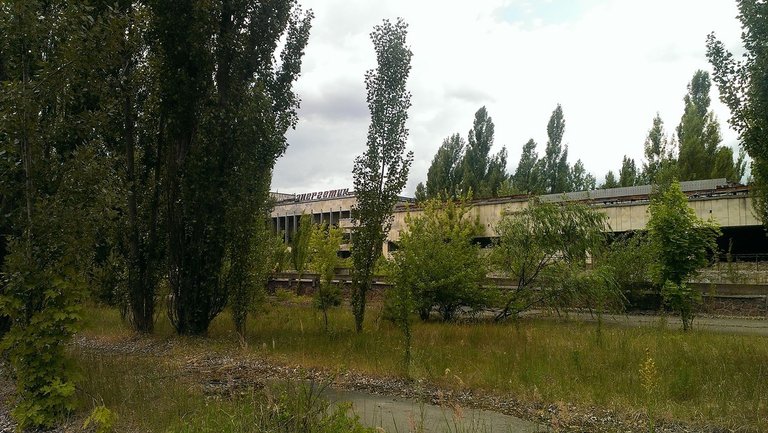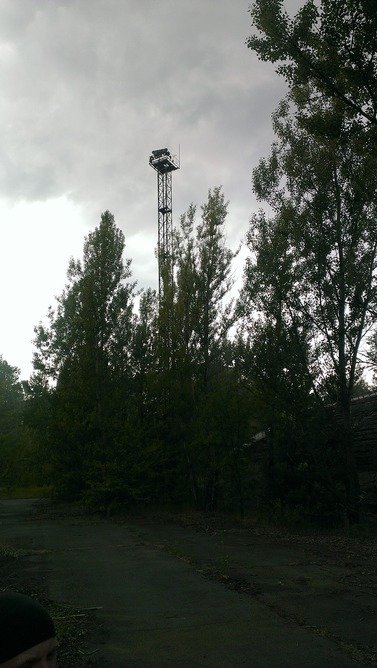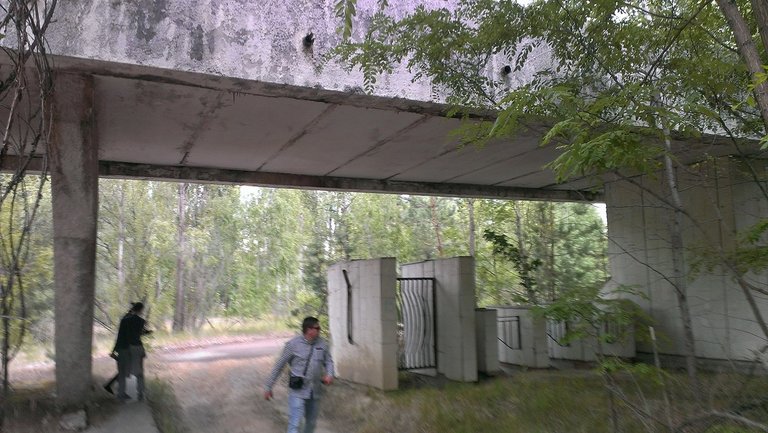
Are you still with me? I hope nobody got lost so far. In Part IV of our Chernobyl tour, we got a first glimpse of the Chernobyl NPP and its exploded reactor No. 4, we made a short stop near the former Red Forest and finally reached Pripyat, where we explored the town square and went inside 'Energetik' – the city's former "Palace of Culture".
Now, let's go for a sightseeing walk through Pripyat and find out what other interesting places we can discover.
You Don't Need a Ticket for these Carousels

This beautiful ferris wheel probably doesn't need an introduction. It should be the first thing that comes to mind when you think of Pripyat, since it appeared in countless documentaries, newspaper articles, artistic images and video games. We have entered the Pripyat Amusement Park, which is about 5 or 10 minutes away from the townsquare.

There are two interesting things to note about the amusement park. First, it wasn't nearly finished when the city was evacuated and it was barely operational at the time of the NPP disaster. Remember, Pripyat was a relatively young Soviet model city built in 1970 – many things were still under construction. Besides the ferris wheel and the bumper cars you see above, there is barely anything noteworthy about the park.
However, the second thing worth mentioning is something you don't see, which are the hightened radiation levels in this park –particularly near the bumper cars. Remember how I explained to you in the last part that all big open areas in Pripyat were used as landing places for planes that were meant to chemically cleanse the city after the disaster (and in effect they just carried radiation from the air to the ground)? Since the amusement park was barely finished at the time, the asphalt here was also used for that exact purpose.

In conclusion, I have to say that it is kinda ironic how closely associated this amusement park became with Pripyat and Chernobyl, since it's one of the few places that has actually barely seen human activity before the nuclear fallout. Yet people like abandoned objects that are related or belonged to children, because it is particularly creepy I guess. So, let's make this extra-cheesy and tune out with a Soviet Young Pioneer Song before we move on.

The only other attraction in the amusement park besides the ferris wheel and the bumper cars. Otherwise, it is just an empty square.
Roses of Pripyat

The storyline and the pictures are not going to correspond 100% in this section, but bear with me and read on – I promise that this is worthwhile. After leaving the Pripyat Amusement Park, we walked into something that looks like a completely wild field of weeds and flowers. I wasn't even sure whether we are in the city anymore. That is because we were standing in the midst of the playing field of Pripyat's former football stadium, which you see pictured above. It honestly takes a while to reach the stadium and to figure out where you are.
The stadium does look cool, but what's more interesting are the occasional wild roses that grow on the former playing field. Unfortunately, I didn't take a photo, but there is a story behind them.
In more optimistic times, the city of Pripyat wanted to plant a rose for each of its inhabitants and they were just a few thousand roses short of their goal when disaster struck them. However, those roses spread their seeds after all the people in whose name they were planted were long gone, and now you find them in many places of Pripyat – particularly around the football stadium. Fascinating, isn't it?

A Walk Through the City

We are leaving the football stadium and are on our way to the Azure Public Swimmingpool. Let's not rush and take a look around, though.

Is this a city or a forest? You tell me!

See that circle around the tree? I love this picture, because I know that this one tree was planted by humans, to make their city green and beautiful. Maybe it's the parent of the wild trees around it?

This used to be a two lane street. Nature took back the other lane.

Always drive carefully.
Just 20 Years Too Late for the Pool Party

We reach the entrance of Pripyat's Public Swimmingpool, Azure. I recommend you to google for pictures of it while it was still functioning about 20 years ago.
Wait, 20 years? Exactly, this pool was actually functioning up until 1998, 12 years after the Chernobyl disaster. It was used as a water reservoir, but also as a normal swimming pool for the workers who built the sarcophagus over reactor No. 4.

This is the entry court. I really wonder why it is so devastated if the pool has been decomissioned not all too long ago? But I have no answer to that.


The pool doesn't look that much better, either. It was clearly vandalised by graffity spraying "Stalkers" who like to intrude into the zone illegaly. However, the structures are still beautiful and this is certainly one of the better preserved places in Pripyat.

I wonder whether the timer still works? I don't think it has a very complicated mechanic. It would be cool if you could start it again.

In a side room, Azure also has its very own basketball court. As with the football court we saw in Energetik, the floor here is extremely well preserved and high quality. I wonder what made Soviet court floors so resistant against time and nuclear disasters?
-------------------TO BE CONTINUED-------------------
We will stay in Pripyat for another part! Unfortunately, I have overpromised in the outro of Part IV. We won't make it to the abandoned 16 story building and the rooftop views over Pripyat yet, but we will do this in the upcoming Part VI of our Chernobyl tour, where we also are going to drive up close to reactor No. 4 and feed giant fish in the pond of the NPP! Stay tuned and don't get lost in the zone! Make sure to follow me and resteem my posts. :)
Awesome Post, but kind of spooky to be honest :D
Once again a great post! I really like the pictures of the insides of the school. An interesting portrait of how the world might look after we're gone!
How much of the city is explorable now? I would have expected there to be some uninhabitable zones still?
Well, the whole city is uninhabitable, but it's safe to stay in most of the places for a while. Pripyat itself, as I've mentioned in the last part, is barely polluted because it was not covered by the radiation release traces from Chernobyl NPP. Places that are closed to tourists include the inside of reactor No. 4, the area formerly covered by the Red Forest and the vehicle graveyard of decomissioned vehicles that were used in the relieve operations for Pripyat and the Chernobyl NPP after the explosion.
Ah yeah that's sort of what I thought. It's amazing to me that there are areas you can explore like that, with no suits or anything. But from your article I take it people still do explore the zones that are closed to tourists? Must still be a lot of interesting places to see, deep in the irradiated zones
Nah, the closed zones are not only closed, they are literally deadly. You will get radiation poisoning if you go there. "Stalkers" just visit the zone without permission and explore on their own, they are mostly harmless adventurists. A friend of mine crossed illegally and his group had an overnight stay in one of the abandoned houses of Pripyat. However, there actually is still police in Pripyat and it even has its own road police, so they can catch you if you are not careful.
Yeah that's what I figured. I hope to one day at least be able to check out the safe zones!
This is very fascinating. With all of the fear and hype about nuclear fallout, shouldn't we see scorched earth in this whole area? I remember watching this documentary about a year ago regarding Ukrainian babushkas.
https://www.pri.org/stories/2016-04-26/30-years-after-chernobyl-these-ukrainian-babushkas-are-still-living-their-toxic
A fascinating character surrounding the myths and lies about the dangers of nuclear exposure was Galen Winsor. Search his stuff, as he shows some interesting ideas that debunk some of these popular myths.
Thanks for sharing!
I actually met one of these women in Part I. Yeah, if you know exactly where the spots with unusual radiation levels are located, you can still live in most parts of the zone. Yet it would be impossible for thousands of people to return and of course agriculture is also out of the question on a sufficient scale. It only works for very few people.
Awesome pictures!